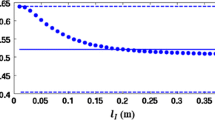Abstract
This paper analyses failure mechanisms and apparent size effects in the biaxial tensile-compressive behaviour of concrete. To this end, a probabilistic discrete crack model is used to numerically determine failure surfaces in the tensile-tensile and tensile-compressive loading range, on account of size effects being considered as volume effects. The results (failure mechanisms, crack patterns, volume effects, etc.) are discussed in some detail with respect to the applied loading state. Size effects on the failure surface are quantified in terms of stress-invariant ratios at peak load for 8 loading paths. It is found that size effects decrease with increasing hydrostatic pressure,i.e. when passing from the tensile loading range into the tensile-compressive range. This can be explained by the activation of friction at the crack lips in a stable crack propagation, which regularises mechanical volume effects, and thus apparent size effects.
Résumé
Dans cet article sont analysés les mécanismes de fissuration et les effets d'échelle dans le comportement biaxial du béton. Pour ce faire, un modèle probabiliste de fissuration discrète a été utilisé afin de déterminer numériquement les surfaces de rupture en prenant en compte les effets d'échelle, considérés comme des effets de volume. Les résultats (mécanismes et chemins de fissuration, effets de volume…) sont discutés en détail au regard du chargement appliqué. Les effets d'échelle sur la surface de rupture sont quantifiés en terme de rapports d'invariant de contrainte relatifs au pic de chargement, ceci pour 8 chemins de chargement. Il est trouvé que les effets d'échelle diminuent avec l'augmentation de la pression hydrostatique. Ceci est expliqué par l'activation des frottements entre les lèvres des fissures lors d'une propagation stable de celles-ci, qui tend à atténuer les effets de volume, et donc les effets d'échelle apparents.
Similar content being viewed by others
References
Bazant, Z. P., Editor, ‘Fracture Mechanics of Concrete Structures’, Proc., FraMCoS1 (Elsevier, London, 1991).
Rossi, P., and Wu, X., ‘Probabilistic model for material behaviour analysis and appraisement of concrete structures’,Mag. Concr. Res. 44 (161) (1992) 271–280.
Rossi, P., Wu, X., Le Maou, F., and Belloc, A., ‘Scale effect on concrete in tension’,Mater. Struct. 27 (1994) 437–444.
Rossi, P., and Guerrier, F., ‘Application of a probabilistic discrete cracking model for concrete structures’, in ‘Fracture and Damage in Quasi-brittle Structures: Experiment, Modelling and Computer Analysis’, Eds. Z.P. Bazantet al. (E. & F.N. Spon, 1994) 303–309.
Rossi, P., Ulm, F.-J. and Hachi, F., ‘Compressive behaviour of concrete: physical mechanisms and modelling’,J. Engng. Mech. ASCE 122 (11) 1038–1043.
Torrenti, J.M., Benaija, E.H. and Boulay, C., ‘Influence of boundary conditions on strain softening in concrete compression test’,J. Engng. Mech., ASCE 119 (12) (1993) 2369–2384.
Kupfer, H., Hilsdorf, H.K. and Rusch, H., ‘Behaviour of concrete under biaxial stresses’,ACI Journal 66 (8) (1969) 656–666.
Torrenti, J.M., Desrues, J.M., Benaija, E.H. and Boulay, C., ‘Stereophotogrammetry: a means of visualizing strain localization in concrete under compression’,J. Engng. Mech., ASCE 117 (7) (1991) 1455–1465.
Chen, W.F., ‘Plasticity in reinforced concrete’ (McGraw-Hill Inc., 1982).
Acker, P., Boulay, C. and Rossi, P., ‘On the importance of initial stresses in concrete and of the resulting mechanical effects’,Cem. & Concr. Res. 17 (1987) 755–764.
Weibull, W., ‘A statistical theory of the strength of material’,Ing. vet. ak. Han. 151 (1939).
Author information
Authors and Affiliations
Additional information
Editorial note P. rossi and F.-J. Ulm work at the Laboratoire Central des Ponts et Chaussées, a French RILEM Titular Member. Pierre Rossi was a member of RILEM Technical Committee 90-FMC on Fracture Mechanics of Concrete; he is still active as a member of the Editorial Group of this Committee. He is also participating in the work Technical Committee 162-TDF on Test and Design methods for steel Fibre reinforced concrete. Dr. Rossi was awarded the Robert l'Hermite Medal for 1996. Dr. Ulm is a member of RILEM Technical Committees 114-CCS on Computer programmes for Creep and Shrinkage analysis of concrete structures and TC 161-GMC on Modelling the behaviour of Concrete in service: a Guide for the engineer.
Rights and permissions
About this article
Cite this article
Rossi, P., Ulm, F.J. Size effects in the biaxial tensile-compressive behaviour of concrete: physical mechanisms and modelling. Mat. Struct. 30, 210–216 (1997). https://doi.org/10.1007/BF02486178
Issue Date:
DOI: https://doi.org/10.1007/BF02486178




